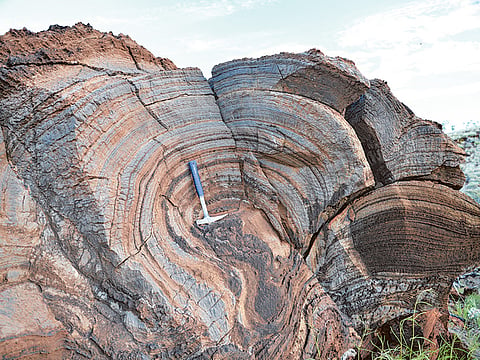Secrets of life on early Earth and other planets
Scientists have found the Earth’s atmosphere was quite thin, raising hope organisms could exist on planets yet to be discovered

Some 2.7 billion years ago, lava started oozing out of a crack in the planet in what is now Australia. It spread and spread, flowing out in every direction until it hit seawater. Then, swiftly, it hardened into rock.
As the lava surged upwards, gases that had dissolved under the high pressures of Earth’s interior expanded and formed bubbles — much the way a bottle of soda fizzes when you unscrew the cap. Those bubbles were frozen in time when the lava that contained them solidified.
Fast-forward millions upon million of years, and those bubbles are some of the best clues scientists have about what early Earth was like. It’s pretty different from how we had imagined it.
That’s according to a study published last month in the journal “Nature Geoscience”, which found that the atmosphere 2.7 billion years ago was half as thick as it is today. The find comes as a surprise to scientists, who had always assumed the opposite was true. The Sun was 20 per cent weaker in the early days of Earth, so researchers thought that a thick atmosphere worked like a down comforter to trap sunlight and keep the planet warm enough to sustain life.
Now it looks as though the atmosphere was less of a thick blanket than a thin sheet. But somehow life was able to hang on amid conditions that seem wildly inhospitable. If that’s true on Earth, could it be true on other planets, as well?
Sanjoy Som, an astrobiologist at Nasa and the lead author of the study, has asked that same question.
For Som, the new study confirms something he was already starting to believe. Four years ago, he analysed fossilised raindrop imprints and found that there was no way the atmosphere could have been as thick as it would need to be for a greenhouse effect to keep the planet warm. But he and his team members didn’t realise exactly how thin the primordial atmosphere was until they started looking at the pristine preserved lava floes of the Australian outback.
By measuring the size of air bubbles trapped in the top of the rock (which were constrained by air pressure) and comparing them to the smaller bubbles lower down (which were under pressure from the air and the rock), the researchers were able to gauge what the atmosphere would have been like.
“It’s really bold, really ambitious and fraught with difficulties,” Dork Sahagian, a geologist at Lehigh University in Pennsylvania who came up with the lava bubbling technique, said. “But you’ve got to try it. It’s as good a proxy of the pressure as you can hope to find.”
Not only did the lava bubbles show that Earth’s atmosphere wasn’t thick — it was incredibly thin. Som and his colleagues estimate atmospheric pressure during the late Archaean at 0.5 bar; 1.013 bar is Earth’s current atmospheric pressure at sea level.
The culprit was probably tiny organisms that sucked nitrogen — the element that makes up about 80 per cent of the atmosphere — from the air. That process, called nitrogen fixing, still happens today, but the gas that is removed is replaced by other biological processes. The organisms that release nitrogen back into the air rely on oxygen, a gas that wouldn’t become available in the atmosphere until the Great Oxidation Event a few hundred million years later.
“The levels of nitrogen gas have varied through Earth’s history, at least in Earth’s early history, in ways that people just haven’t even thought of before,” said co-author David Catling, a professor of Earth and space sciences at the University of Washington, said. “People will need to rewrite the textbooks.”
But it’s still too early to start throwing away the old ones. Fossilised evidence of liquid water on the surface proves that the planet wasn’t frozen solid by the early Sun’s meagre rays, and past research has suggested that even incredibly high levels of greenhouse gases such as methane and carbon dioxide would not have been sufficient to keep the planet warm. A 2009 study showed that the greenhouse effect might have been boosted by increased nitrogen pressure — but that’s the opposite of what Som’s lava bubbles suggest.
This leaves scientists in a bit of a bind, Colin Goldblatt, the University of Victoria atmospheric chemist who authored that study, said.
“With such little pressure, it’s going to be very hard to account for the warm temperatures,” Goldblatt said. He would like to see studies of rocks from other time periods supporting Som’s find.
Whatever was going on, it’s clear that early Earth would have been unrecognisable to living things today, Som said. The Moon was closer so tides were stronger. The planet rotated more quickly on its axis so the days were shorter.
All this demonstrates that “a planetary environment completely different than modern Earth can sustain life on its surface”, Som, who worked on the study while at the University of Washington and is now based at Nasa’s Ames Research Center in California, said. And if organisms can live on a planet like that, perhaps they can live on planets that humans haven’t discovered yet.
“Life doesn’t need conditions like modern Earth to survive and thrive,” Som added. “This is important in our quest for habitable environments in extra-solar planets.”
–Washington Post
Sign up for the Daily Briefing
Get the latest news and updates straight to your inbox


